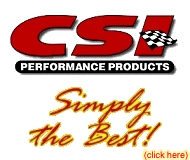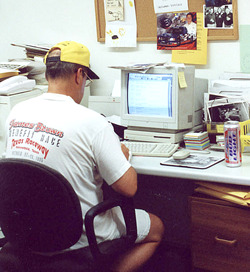|
|
 |
||||||||||||||||||||||||
 |
|
||||||||||||||||||||||||
A JOURNEY WITH ERNIEI think anybody who has been going to the drags for awhile has, at one time or another, been involved in the following kind of conversation. "I remember one time we drove to Englishtown, New Jersey and it rained, so we kept right on going to Maple Grove in Pennsylvania because they had a Top Fuel show there. We fought our way through rain, sleet and snow, and just when it all looked hopeless, the clouds broke 20 miles before we got to the track. We got there just in time for the first round and had a ball." In other words, drag race fans like all sports buffs have personal remembrances that show how hardcore an aficionado they are. Those days are pretty much over now for most of the straight-line set. You have the 23 NHRA national events and the dozen IHRA shows and that's it for pro drag racing. Dismal stuff. No more U.S. 30 at Gary on Friday night, U.S. 131 in Michigan on Saturday, Union Grove or Gary on Sunday, and Canada on Monday morning. The demolition of the match-race scene has also dissolved much of the potential for war stories getting to and from the drags and, for that matter, happenings at the races themselves. The Dockers/bottled water/SUV era has its share of casualties. The only hardcore yarns you get out of those are something on the lines of, "We sat in the mobile home and tanked up for the first weekend and then came back next week and saw the show, etc., etc." I was fortunate, if that's the right word, to have experienced a number of travails associated from the match-race era, none more so than an October race in 1965 where my brother Ernie and I decided on going to Lions for a UDRA Northern Chapter vs. Southern Chapter Top Fuel show. Big deal, right? Not really. In 1965, I had just turned 18 and did not have a car. I usually counted on my older friends to get my ass to the shows, but they were all tied up and couldn't attend a feature that looked can't-miss. I did have transportation, so all was not lost. Somewhat regrettably, it was a 1964 Honda 50. If you remember what those look like, you've dated yourself fairly accurately. They were essentially a skinny little motor scooter encased in plastic with an engine that could barely power a six-volt Sunbeam razor. Still, for short jaunts to school, the store, and other trivia, they weren't all that bad. With the wind at your back and downhill, you could almost get up to 50-55 mph on one of these mosquitoes. Complications set in, though, when you wanted to take yourself and, in my case, your bigger, younger brother Ernie piggyback on one of the little buggers from North Hollywood, 50 to 60 miles to Wilmington, California where the track was. The weight load atop the bike doubled its actual shipping weight and the length of the journey guaranteed that the Honda would, as John Force might put it, "have its tongue hangin' out.'" There was another factor involved, too, a sociological one. Our trip was not going to be a colorful sprint down the Pacific Coast Highway, but a jaunt through an area that had been on the fringes of the Watts Rebellion four months earlier. It wasn't until I began to map out our journey a day before the actual trip that I got hipped to this. When the actual trip started out, it was a relatively uncomplicated affair. Ernie and I still lived with my folks in North Hollywood and all we had to do was get to Ventura Blvd., the main drag of the southern San Fernando Valley outside L.A., and take it over the Hollywood Hills into Hollywood. Ventura turned into Cahuenga Blvd., at the Universal Studios as you approached the Hills, and Cahuenga dropped down to Franklin Ave., a road that skirted the Hollywood Hills on the L.A. or non-San Fernando Valley side. When we got to Franklin and Western, I would hang a right and drive Western Ave., one of the longest north-south streets in L.A., all the way down to Alameda, where I'd hang a left and take it to 223rd St. where the track was located. Western went through all kinds of neighborhoods. At Hollywood and Western,
a now extremely seedy part of town, one would make his or her way south
past film processors, photo studios, bars for all persuasions, pool
halls, and car lots, but by the time you had gone to Western in the
20s and 30s, the composition of the nearby neighborhood took on a rougher
look. |
|||||||||||||||||||||||||
|
Copyright 1999-2001, Drag Racing Online and Racing Net Source |
|
||||||||||||||||||||||||


